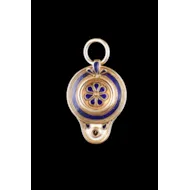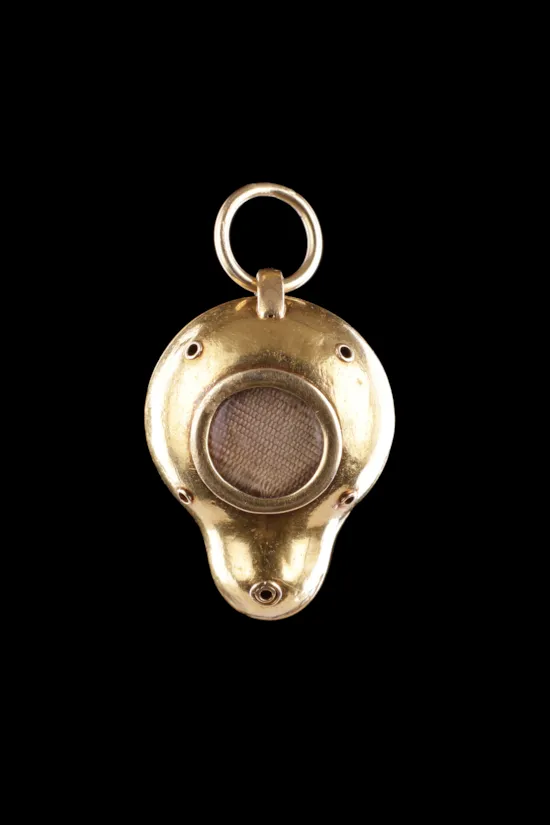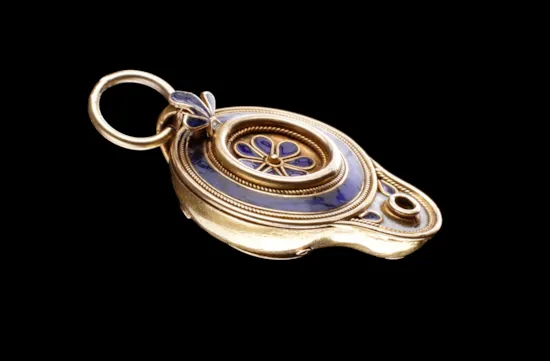Exceptional Vinaigrette / Pendant Attributed to Fortunato Pio Castellani
An Exceptionally Fine Vinaigrette / Pendant Attributed to Fortunato Pio Castellani (1794 - 1865)
The pendant in the form of an ‘Ancient Roman’ Oil Lamp
Gold, Enamel, Human Hair
Italy
Circa 1860
SIZE: 1cm high, 1.7cm wide, 2.5cm deep (without loop) - ³⁄₈ ins high, ⁴⁄₈ ins wide, 1 ins deep (without loop)
The pendant in the form of an ‘Ancient Roman’ Oil Lamp
Gold, Enamel, Human Hair
Italy
Circa 1860
SIZE: 1cm high, 1.7cm wide, 2.5cm deep (without loop) - ³⁄₈ ins high, ⁴⁄₈ ins wide, 1 ins deep (without loop)
An Exceptionally Fine Vinaigrette / Pendant Attributed to Fortunato Pio Castellani (1794 - 1865)
The pendant in the form of an ‘Ancient Roman’ Oil Lamp
Gold, Enamel, Human Hair
Italy
Circa 1860
SIZE: 1cm high, 1.7cm wide, 2.5cm deep (without loop) - ³⁄₈ ins high, ⁴⁄₈ ins wide, 1 ins deep (without loop)
The pendant in the form of an ‘Ancient Roman’ Oil Lamp
Gold, Enamel, Human Hair
Italy
Circa 1860
SIZE: 1cm high, 1.7cm wide, 2.5cm deep (without loop) - ³⁄₈ ins high, ⁴⁄₈ ins wide, 1 ins deep (without loop)
In the 19th century, one of the most famous jewellers that defined European trends was Fortunato Pio Castellani. Born in 1794, Castellani began work as a master goldsmith in his father’s workshop before opening his own shop in Rome in 1814. Then, in the 1850’s, he began attracting attention for being a leading figure in what was called the ‘classical revival’, the surging interest in old-style Grecian jewellery techniques. While jewellers up until that point often did not pay too much attention to history, doubting the relevance of long-gone fashions to the present-day, Castellani and his two sons, who joined him in his workshop, were fascinated with ancient jewellery techniques and sought to apply them to their own work.
Castellani was particularly interested in Greek and Etruscan classicism. His workshop would produce stunning gold jewellery pieces that used classical motifs like shells, urns, and amphorae. What was particularly special about Etruscan jewellery was its ‘granulation’ technique. Granulation involved covering a gold surface with small granules of precious metal, allowing for very detailed and delicate designs. Castellani studied Etruscan granulation closely, and later claimed to have discovered the secret method behind it, though never revealing this in public.
Castellani’s Estrucan-inspired designs became all the rage across Italy, France, and England. His workshop was often visited by members of the aristocracy. Fashionable women wore their bracelets and fringed necklaces in Greek style, brooches with Latin and Greek inscriptions and oak-leaved diadems. His workshop, by that point under the direction of his sons Alessandra and Augusto, became involved in helping the trade of antiquities, sponsoring excavations and restoring artefacts.
Castellani was particularly interested in Greek and Etruscan classicism. His workshop would produce stunning gold jewellery pieces that used classical motifs like shells, urns, and amphorae. What was particularly special about Etruscan jewellery was its ‘granulation’ technique. Granulation involved covering a gold surface with small granules of precious metal, allowing for very detailed and delicate designs. Castellani studied Etruscan granulation closely, and later claimed to have discovered the secret method behind it, though never revealing this in public.
Castellani’s Estrucan-inspired designs became all the rage across Italy, France, and England. His workshop was often visited by members of the aristocracy. Fashionable women wore their bracelets and fringed necklaces in Greek style, brooches with Latin and Greek inscriptions and oak-leaved diadems. His workshop, by that point under the direction of his sons Alessandra and Augusto, became involved in helping the trade of antiquities, sponsoring excavations and restoring artefacts.
SEE: For an identical example in the Royal Collection, see: RCIN 65268, given to Queen Victoria by Albert Edward, Prince of Wales, 4th December 1862, in memory of his father’s, Prince Consort’s death anniversary, 14th December 1861
Exceptional Vinaigrette / Pendant Attributed to Fortunato Pio Castellani

SOLD










YOU MAY ALSO LIKE

